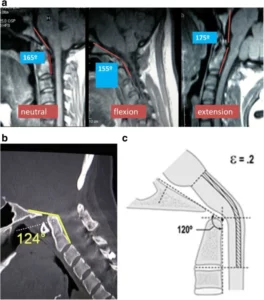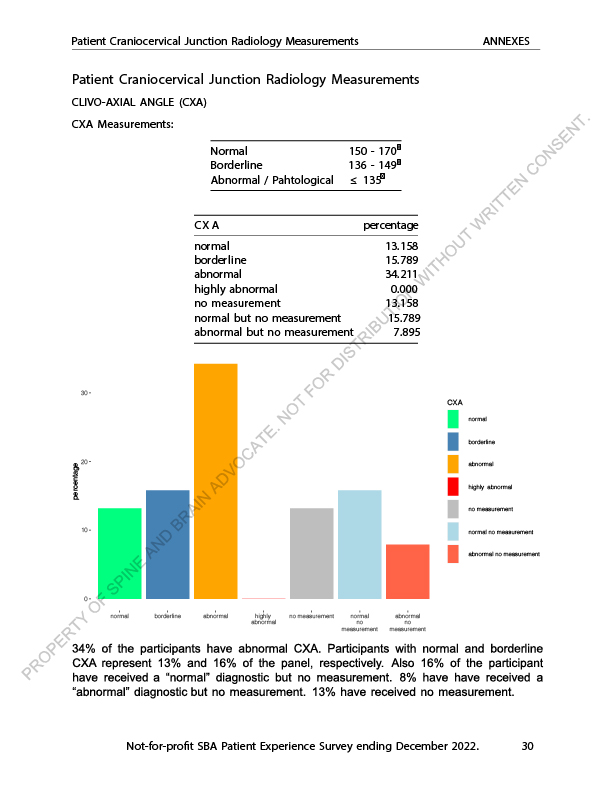Clivo-axial Angle (CXA)
In this section you will find information about the Clivo-axial Angle (CXA) Radiology Measurement as follows:
- Basic Anatomy
- What are causes of abnormal CXA measurements?
- What symptoms does abnormal CXA measurement produce?
- What are some structural abnormalities associated with abnormal CXA measurements?
- What is Clivoaxial Angle (CXA)?
- Static and Dynamic Imaging
- Excerpt from CCJ Patient Experience Survey 2022 – Participant CXA Measurement Summary
- Abnormal CXA and it relation to neurodegenerative disorders
- What conservative and surgical treatments are available?
- Article: Utility of the clivo-axial angle in assessing brainstem deformity: pilot study and literature review
- CXA – A World-Renowned CCJ Measurement – Additional article clips on CXA from USA, Canada, India, Phillipines, Austria/Turkey/Afganistan.
1. Basic Anatomy
The cervical spine is connected to the head in an upright position, and it needs to be tilted to allow fluid like Cerebrospinal Fluid (CSF) to flow up to the brain. This tilt is measured by the clivoaxial angle (CXA).
2. What are causes of abnormal CXA measurements?
Many conditions (congenital and acquired) cause abnormal CXA and Harris measurements. This includes Chiari malformations, kyphotic CXA. osteogenesis imperfect, achandroplasia, Down’s syndrome, Ehlers Danlos Syndrome (EDS), inflammatory conditions like rheumatoid arthritis and lupus, trauma involving the neck region, and infections like TB spondylitis.
3. What symptoms does abnormal CXA measurement produce?
Common symptoms include reduced neck range of motion, neck pain, sleeplessness, feeling of faintness, pain around the ear, ringing in the ear, feeling of spinning, vision problems, paresthesias (numbness), and problems controlling urine and bowel movement.
4. What are some structural abnormalities are associated with abnormal CXA measurements?
Abnormal CXA measurements, for example a kyphotic CXA of 124° (Figure 1) result in a mechanical deformity and lengthening of the brainstem and upper spinal cord.
Figure 1 Reference
Image from Article “Cervical medullary syndrome secondary to craniocervical instability and ventral brainstem compression in hereditary hypermobility connective tissue disorders: 5-year follow-up after craniocervical reduction, fusion, and stabilization” by Fraser C. Henderson Sr, C. A. Francomano, M. Koby, K. Tuchman, J. Adcock and S. Patel

a The normal CXA. The normal CXA is approximately 155°, decreasing 10° in flexion and increasing 10° in extension.
b The pathological clival axial angle (CXA) is more kyphotic than the normal CXA. The CXA is subtended by the posterior axial line and a line drawn along the surface of the lower third of the clivus. An angle of 135° or less is considered potentially pathological. The kyphotic CXA of 124° shown here is clearly pathological and results in a mechanical deformity and lengthening of the brainstem and upper spinal cord.
c Diagrammatical rendering of a kyphotic CXA. In hereditary connective tissue disorders, ligamentous laxity may thus result in a kyphotic CXA in flexion, with a concurrent increase in strain.
5. What is Clivoaxial Angle (CXA)?
- Clivo-axial Angle – CXA is the angle between the Clivus and the backside of the Dens (C2) and is approximately 155o ranging between (135–179°).
- CXA of <135° like kyphotic CXA of 120° is considered abnormal because it means that the cervical spine has become more curved which can result in compression of the brainstem, spinal cord, and other contents of foramen magnum. This can cause functional Chiari Malformations and biomechanical neuroaxial stress.
6. Static and Dynamic Imaging
Imaging of Craniocervical Instability may be done while you are lying down (static imaging), or in a standing position, while moving your neck (dynamic imaging). For that, diagnostic measurements like clivo-axial angle (CXA), Harris measurements basion-dens interval (BDI), and basion-axial interval (BAI) have different values depending on the imaging situation.
For dynamic imaging, Anoushesh et. al and colleagues reported a mean value for extension CXA as 169.20°, and 144.73° for flexion CXA. Reference
7. Excerpt from CCJ Patient Experience Survey 2022 – Participant CXA Measurement Summary

8. Abnormal CXA and it relation to Neurodegenerative Disorders
An abnormal CXA, like kyphotic CXA, can result in stretching of the nerve bundles that are contained within the brain stem and spinal cord leading to the collection of small proteins that make up the cell body (neurofilament) in the cable-like fibers (axons) that carries electrical signals between nerve cells, which cause cell death (apoptosis). This may lead to faulty craniospinal hydrodynamics increasing the chances of neurodegenerative disorders such as Alzheimer’s, Parkinson’s, multiple sclerosis, obstructive sleep apnea, and others.
9. What conservative and surgical treatments are available?
Conservative management includes physical therapy, curve restoration therapy, upper cervical chiropractic, prolotherapy or platelet rich plasma injections into ligaments and muscles that may cause them to tighten or get stronger.
Surgical interventions include Surgical Fusion of all or some of the craniocervical joints.
Foramen magnum decompression (FMD) which is the primary surgical treatment for symptomatic CM1.
10. Article: Utility of the clivo-axial angle in assessing brainstem deformity: pilot study and literature review
“There is growing recognition of the kyphotic clivo-axial angle (CXA) as an index of risk of brainstem deformity and craniocervical instability. The CXA is a useful sentinel to alert the radiologist and surgeon to the possibility of brainstem deformity or instability.
Ten adult subjects with ventral brainstem compression, radiographically manifest as a kyphotic CXA, underwent correction of deformity (normalization of the CXA) prior to fusion and occipito-cervical stabilization (surgery”. The subjects were assessed pre-operatively and at one, three, six, and twelve months after surgery, using established clinical metrics: the visual analog pain scale (VAS), American Spinal InjuryAssociation Impairment Scale (ASIA), Oswestry Neck Disability Index, SF 36, and Karnofsky Index. Parametric and non-parametric statistical tests were performed to correlate clinical outcome with CXA.
11. Additional Article Clips on Clivo-axial Angle (CXA)
The Clivo-axial Angle is recognized around the world and utilized in majority of continents. Here are a few articles showing that CXA is a world renowned craniocervical junction measurement used in Radiology and by Neurosurgeons.
USA Article
“No major complications were observed. Two patients showed pedicle screws adjacent to but not deforming the vertebral artery on post-operative CT scan. All clinical metrics showed statistically significant improvement. Mean CXA was normalized from 135.8° to 163.7°. Correction of abnormal CXA correlated with statistically significant clinical improvement in this cohort of patients. The study supports the thesis that the CXA maybe an important metric for predicting the risk of brainstem and upper spinal cord deformation. Further study is feasible and warranted.” USA Reference
Canadian Article
“Based on our systematic review, we recommend that the CXA, Harris measurement (BDI & BAI), Grabb-Mapstone-Oakes measurement, and the angular displacement of C1 to C2 be used to evaluate suspected CCI in EDS patients. Surgical fixation of suspected CCI should only be performed in cases with clear radiographic presence of instability and concordant symptoms/signs. Consensus-based guidelines and care pathways are required.” (Canada) Reference
India and USA Article
“Basilar invagination is an abnormality at the craniovertebral junction, either congenital or degenerative, resulting in the odontoid prolapsing into the already limited space of the foramen magnum. It is commonly associated with conditions such as Chiari malformation, syringomyelia, and Klippel-Feil syndrome. Clinical presentations can range from chronic headaches, limited neck motion, and acute neurologic deterioration. CT and MRI are critical to diagnosing and managing this condition, including operative planning when needed…” USA, India Reference
Philippines Article
“There has been a drastic rise in patients with neurodegenerative and functional disorders in the past decade, and early detection of such conditions is not yet feasible. Upright posture and motion of cervical spine increase the strain in craniocervical junction (CCJ) which is a crucial tollgate for cerebrospinal fluid and blood flow between spinal canal and cranial vault that may lead to faulty hydrodynamics in the craniospinal region and furthering to edema, chronic ischemia, and hydrocephalus…
The clivoaxial angle (CXA) or upper cervical angle and cranial base angle, both are important for the function of the brainstem and cord. As classically described by Chamberlain, a lower than normal CXA (150–165°) compresses the brainstem, cord, contents of foramen magnum, and spinal canal . This not only causes functional Chiari formations but also predisposes the individual to biomechanical neuraxial stress which is manifested by myelopathy, bulbar symptoms, and neck pain or headache…
Biomechanics and mechano-biology are closely interrelated, neuronal bundles being the pathological substrate of deformative stress in this case due to kyphotic CXA directly leading to stretch triggered accumulation of neurofilament in axons and thus apoptosis. An abnormal CXA may lead to faulty cranio-spinal hydrodynamics increasing the chances of neurodegenerative disorders such as Alzheimer’s, Parkinson’s, multiple sclerosis, obstructive sleep apnea, etc….” (Philippines) Reference
Case Study Article by Austrian Trained Physician
A severe case of platybasia and basilar invagination. Platybasia can be caused by a wide variety of congenital and acquired diseases.
A. Clivoaxial angle = 83 degree (cut-off value: 138.5 degree)
B. Clivodens angle= 69.8 degree( cut-off value: 123.5 degree)
C. Clivopalate angle= 6.6 degree (cut-off value: 53.5 degree)
D. Odontoid pig above Chamberlain’s line: 20 mm (cut-off value: 3 mm)
E. Skull base angle: 172 degree (cut-off value: 143 degree)
Additional References
- Fraser C. Henderson Sr, C. A. Francomano, M. Koby, K. Tuchman, J. Adcock, S. Patel. Cervical Medullary Syndrome Secondary to Craniocervical Instability and Ventral Brainstem Compression in Hereditary Hypermobility Connective Tissue Disorders: 5-year Follow-up after Craniocervical Reduction, Fusion, and Stabilization. 2018. (1-17). https://www.researchgate.net/publication/330271077_Cervical_medullary_syndrome_secondary_to_craniocervical_instability_and_ventral_brainstem_compression_in_hereditary_hypermobility_connective_tissue_disorders_5-year_follow-up_after_craniocervical_redu/link/5fb92ddc299bf104cf672c74/download
- Prawit Sangwanloy, Tanat Vaniyapong, Thunya Norasetthada, Chumpon Jetjumnong. Influence of Clivo-Axial Angle on Outcome after Foramen Magnum Decompression in adult Symptomatic Chiari type 1 malformation 2022 Mar 19. https://www.sciencedirect.com/science/article/abs/pii/S0303846722000956
- Fraser C Henderson Sr, Fraser C Henderson Jr, William A Wilson 4th, Alexander S Mark, Myles Koby. Utility of the Clivo-Axial Angle in Assessing Brainstem Deformity: Pilot Study and Literature review https://pubmed.ncbi.nlm.nih.gov/28258417/
- Venkatraman Bhat, Saurabh Maheshwari, Kishore Kumar BN. Imaging of Normal and Abnormal Cranio-vertebral Junction – A pictorial review. 2021 Mar 3 https://www.heraldopenaccess.us/openaccess/imaging-of-normal-and-abnormal-cranio-vertebral-junction-a-pictorial-review
- The CCJ Instability Institute – Your Craniocervical Instability Treatment Options https://centenoschultz.com/craniocervical-instability-cci/
- Bhusri N, Lim DC. Correlation of clivoaxial angle to skeletal malocclusions: A prescreening for future risk of neurodegenerative disorders. APOS Trends Orthod 2016;6:246-50.
- Chin, A., Perry, S., Liao, C. et al. The relationship between the cranial base and jaw base in a Chinese population. Head Face Med 10, 31 (2014). https://doi.org/10.1186/1746-160X-10-31
- Fraser C Henderson Sr, Fraser C Henderson Jr, William A Wilson 4th, Alexander S Mark, Myles Koby. Utility of the Clivo-Axial Angle in Assessing Brainstem Deformity: Pilot Study and Literature review https://pubmed.ncbi.nlm.nih.gov/28258417/
SBA Ref. Dr. ED 2023

